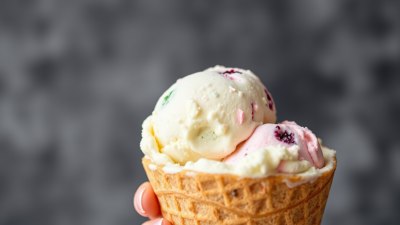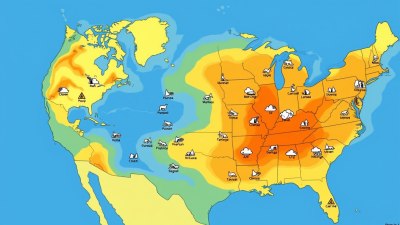Why You Always Think of Ice Cream at the Exact Wrong Time
Explore why your mind craves ice cream at inconvenient moments and how cravings really work.

Image created with Flux Schnell
Have you ever found yourself thinking about ice cream at the exact moment when you’re trying to eat healthy, or after you’ve just had a big meal? The nagging thought of that cold, creamy dessert can strike unexpectedly, often at times when indulging seems most inconvenient or even impossible. This phenomenon isn’t just a quirk of human behavior; it's rooted in psychological, physiological, and even social factors that influence our cravings and decision-making processes.
The timing of food cravings, especially for treats like ice cream, can feel almost cruel. Why does your brain seem to pick the worst possible moments to remind you of your favorite flavors? Let’s delve into the science of cravings, understand what triggers these sudden thoughts about ice cream, and unpack some strategies for managing them.
The Psychology Behind Food Cravings
Cravings are complex mental phenomena tied to emotions, memories, and learned behaviors. When you think of ice cream at a seemingly inopportune time, your brain might be responding to psychological cues or unmet emotional needs. Studies show that cravings are often linked to mood states—stress, boredom, and even happiness can trigger the desire for comfort foods like ice cream.
This relationship between emotions and cravings is rooted in the brain’s reward system. Ice cream, rich in sugar and fat, activates the release of dopamine, a neurotransmitter associated with pleasure. Your brain learns to associate eating ice cream with feelings of reward and comfort, which can cause cravings to arise as a way to seek out those positive sensations again.
Moreover, classical conditioning plays a role. If you usually treat yourself to ice cream after a tough day or during social gatherings, your brain forms strong associative links. Hence, even thinking about stressful events or social situations can inadvertently cue your craving for ice cream because your mind remembers the reward that followed.
Physiological Triggers for Ice Cream Cravings
Physiology also plays a crucial role in when and why ice cream cravings surface. Our bodies maintain energy homeostasis, constantly signaling hunger and satiety, as well as the need for specific nutrients. While cravings can be about seeking pleasure, they sometimes point to nutritional deficiencies or metabolic cues.
For example, craving something cold and creamy could stem from a desire to cool down your body, especially after being exposed to heat or physical exertion. Ice cream’s cold temperature and sugar content provide rapid energy, making it an attractive option when your body is fatigued or dehydrated.
Blood sugar fluctuations are a common physiological trigger. After consuming a high-carb meal, your blood sugar spikes and then drops. This rebound hypoglycemia can trigger cravings for more sugary foods, like ice cream, to quickly restore energy levels. These cravings often appear shortly after meals, especially if the meal was heavy or lacked balanced nutrients like protein and fiber that help stabilize blood sugar levels.
The Role of Habit and Availability
Habit strength and environmental cues strongly influence when and how cravings manifest. Humans are creatures of habit, and the timing of cravings can often be linked to your daily routine or surroundings. If you always have ice cream in your freezer or pass by an ice cream shop on your way home, those cues can prompt cravings at specific times, regardless of hunger.
Availability also affects craving timing. Studies have shown that simply seeing or smelling ice cream can trigger immediate cravings, even if you weren't previously thinking about it. Similarly, being reminded of an upcoming event involving ice cream—like a birthday party—can lead your mind to wander to those creamy scoops in advance.
Additionally, the context in which you're trying to abstain from ice cream may paradoxically increase your thoughts about it. This is due to the psychological phenomenon called the 'ironic process theory,' which suggests that trying to suppress a thought—such as “don’t think about ice cream”—actually makes it more persistent. The more you resist, especially at inconvenient times, the stronger it becomes.
Why Timing Feels So Bad
Cravings seem to hit hardest when indulging would feel guilty or illogical. Exactly why this timing is so frustrating ties into a mismatch between your physical sensations, psychological state, and social environment. It’s common to crave ice cream after a heavy meal when your body is technically not hungry but your brain seeks the reward.
Similarly, late at night cravings tend to be particularly strong. This may be because your willpower is depleted after a long day, and your brain seeks hedonic (pleasure-related) rewards to compensate for fatigue or stress. The late-night environment is also quieter and less distracted, making you more aware of your thoughts and less able to divert attention away from cravings.
You might also notice cravings when you are busy or distracted, which seems counterintuitive. Yet, some research suggests that when your mind isn't fully engaged or when multitasking, your brain can unconsciously shift focus to reward-related memories or desires as a form of cognitive escape.
Can Ice Cream Cravings Be Anticipated or Controlled?
Recognizing the triggers that cause your ice cream cravings is the first step to managing them. Often, cravings are not just about the food itself but about underlying emotional and physiological needs. Keeping a journal of when and why you crave ice cream can help uncover patterns—whether related to stress, specific routines, or situational cues.
Adjusting your diet for more balanced meals rich in protein, fiber, and healthy fats supports blood sugar stability and reduces the sudden onset of cravings. Hydration also plays a key role; sometimes thirst is misinterpreted as hunger or sugar cravings.
When cravings strike, engaging in alternative activities can be effective. Physical activity, breathing exercises, or even brushing your teeth may help distract your brain and reduce the craving intensity. Additionally, maintaining a supply of healthier dessert alternatives like fruit or yogurt can satisfy the craving without leading to guilt or overindulgence.
Mindfulness practices also show promise in craving management. Being aware of your craving sensations and accepting them without judgment can reduce the impulse to act on them immediately. Over time, mindfulness can help rewire your brain’s reward expectations around ice cream and other indulgences.
The Social and Cultural Context of Ice Cream Cravings
Cultural associations often tie ice cream to celebration, reward, nostalgia, and happiness. Advertising and media reinforce these associations, making ice cream a symbol of joy and comfort. These shared meanings deeply influence when and how cravings arise, particularly in social or ritual contexts such as summer outings, parties, or movie nights.
Furthermore, social environments can either help regulate or exacerbate cravings. Being around others who are indulging in ice cream can both trigger and normalize the desire, making restraint more difficult. On the other hand, support from friends and family in adopting healthier habits can reduce craving frequency or intensity.
The Neuroscience of Cravings and Timing
On a neurological level, craving impulses involve several brain regions, including the hypothalamus, the limbic system, and the prefrontal cortex. While the hypothalamus regulates hunger and satiety, the limbic system processes emotions and rewards, and the prefrontal cortex controls decision-making and impulse regulation.
Timing is critical because these systems do not always operate in sync. The desire for ice cream can spike when the limbic system signals reward, but the prefrontal cortex’s self-control mechanisms might be weakened due to fatigue, stress, or distractions. When such misalignment occurs, cravings emerge at inconvenient times.
Neural circuits also adapt with repeated experiences, so habitual cravings get stronger, and the specific timing of cravings becomes more predictable and difficult to override. Understanding this helps explain why resisting ice cream cravings only gets harder when you try to avoid them without addressing underlying habits.
Practical Tips for Navigating Ice Cream Cravings
While ice cream cravings can strike at any time, knowing how to prepare or respond can help you regain control. Here are some straightforward tips:
- Plan Ahead: Designate specific treat times to reduce spontaneous cravings.
- Balance Meals: Include protein and fiber to keep you full longer and stabilize blood sugar.
- Stay Hydrated: Drink water regularly to avoid confusing thirst with hunger.
- Mindful Eating: When you do eat ice cream, savor it consciously to maximize pleasure and reduce overeating.
- Distract Yourself: Engage in light exercise or hobbies to shift your focus.
- Keep Alternatives Handy: Fresh fruit or low-sugar frozen yogurt can be good substitutes.
- Address Emotions: Manage stress with techniques like meditation or journaling instead of turning to food.
- Modify Environment: Limit your access to ice cream during periods when cravings tend to hit.
Implementing these strategies can reduce the frequency and intensity of ice cream cravings at inconvenient times, making indulgence more intentional and satisfying.
Understanding Your Ice Cream Cravings Empowers You
In sum, the seemingly mischievous timing of ice cream cravings is the result of a confluence of psychological triggers, physiological signals, habits, and neural mechanisms. By closely examining your personal context—emotional states, meal patterns, social environment—you can anticipate when cravings might occur and wield strategies to manage them effectively.
This understanding transforms cravings from frustrating, sudden urges into manageable experiences that enhance your overall relationship with food. So next time you find yourself longing for ice cream at an inconvenient moment, remember it’s your brain signaling a complex set of needs—some of which you might satisfy in healthier, more timely ways.
With mindful attention, balanced nutrition, and practical planning, you can enjoy your ice cream without letting cravings dictate your schedule or well-being.











